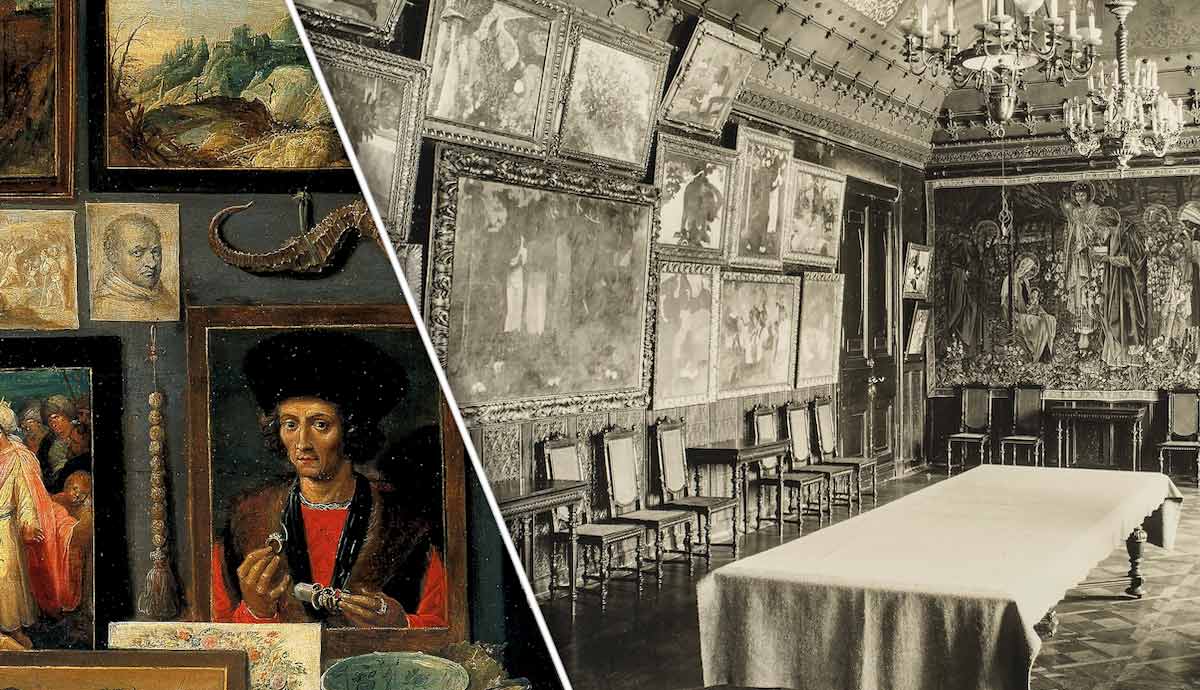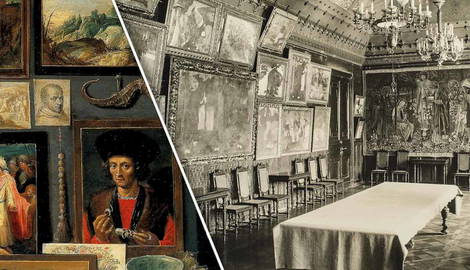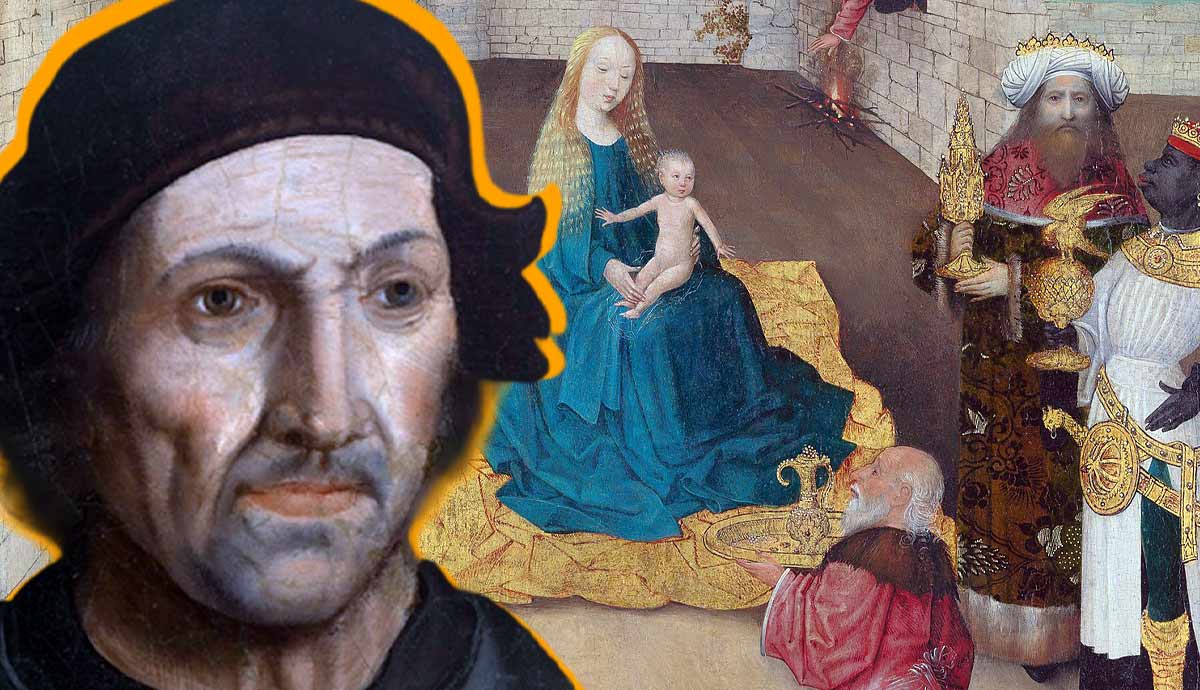
Art collecting is a prestigious hobby and a chance for investment. But how do we decide what is worth collecting, and, more importantly, how did our ancestors come up with this idea in the first place? Read on to explore the most famous art collections and the centuries-long history of collecting art.
The Origins of Collecting Art: From Caves to Temples

Experts on human evolution largely believe that collecting objects is an instinctive behavior that helped our ancestors to survive. Given the scarcity of resources, spotting and accumulating precious objects could ensure the survival of not only the individual but also their community and offspring. As humanity developed further, forming larger communities, hierarchies, and more organized modes of living, the system of needs and requirements became larger.
After satisfying the need for basic necessities, some humans still felt the need to collect things, but this time for non-material purposes. Beautiful objects found their places in homes and altars. Not all of them were pieces of art. For instance, in Ancient Egypt, all objects, no matter how decorated, had utilitarian functions, thus falling out of the category of art. In Ancient Greece, however, wealthy people often ordered statues of gods and heroes to decorate their gardens and houses. Chinese civilization moved much further when it came to collecting. Numerous sources indicate that from the 3rd century CE, the wealthy Chinese collected calligraphy and even fought the already emerging art forgers.

For centuries, beautiful objects remained symbols of status, wealth, and devotion to the higher powers. With the Christianization of Europe, most art was accumulated in places of worship and had practical meanings apart from aesthetic ones. During the European Middle Ages, painting and sculpture were valued for their abilities to pass the message of God to the uneducated masses rather than being acts of creative expression. It all changed as the Renaissance era departed from the fully religious viewpoint to a more humanistic one based on experiences and thoughts.
Renaissance: The Golden Age of Art Commissions

As the Renaissance unfolded in Europe, creations of the human hand started to get more appreciation. In treatises on art and harmony, Renaissance scholars promoted studies of composition and proportion as the universal virtues for any educated man. As the economy developed, some cities, like Venice and Florence, turned into commercial and cultural hubs for the whole continent. The center of artistic activity and art collecting in Europe was in Italy. Affluent families of politicians as well as wealthy merchants invested in art to demonstrate their refined taste and good education.
Another reason for art patronage was the desire to leave their mark on the future: art commissioners often donated the works to the city they lived in, thus securing their name and influence on future generations. Vast art collections accumulated and developed throughout Europe, yet most were kept private.
Among the most famous art collectors and patrons of Renaissance Italy was the Medici family, who used art to secure their influence on the Italian political scene. They supported Michelangelo, Raphael, Benvenuto Cellini, and many other great names of the era. Their works were often presented in public spaces, particularly the propagandistic portraits of the Medici family members which highlighted their good deeds and strong morals.
The Enlightenment: Collecting to Learn

The Age of Enlightenment saw a great shift in the attitude to knowledge and science. Collecting became a popular hobby among intellectuals, yet it was hardly ever limited to art. In that period, cabinets of curiosities were collections of strange objects, overseas souvenirs, or intricate toys. The cabinets of curiosities became a way for aspiring collectors to gather all knowledge of the world under one roof. These were the prototypes of present-day museums, although they usually lacked a systemic approach. These collections illustrated the owner’s status and intellectual level, their love for traveling, and their commitment to self-education. In a sense, the owners were proto-curators who chose how to arrange and display their objects.
In terms of art, the Enlightenment era saw the emergence of public museums as we now know them. Public display of outstanding examples of art was supposed to boost the overall education level, teach the masses about the laws of harmony and beauty, and provoke discussion. Like with curiosity cabinets, the arrangements were mostly chaotic and depended on the restrictions of space rather than on conscious curatorial choice.
The British Museum, which opened in 1753, initially consisted of three private collections of taxidermy, artifacts, and books. The objects on display were mixed and randomly displayed. The first known attempt at a systematic approach happened in the newly opened Louvre in 1792, where museum custodians divided the collection into periods and styles.
How Art Collecting Shaped Modern Art

The 19th century moved the center of art collecting from Italy to France. Collecting and curating art became a popular hobby, with collectors now specializing in certain styles or topics instead of buying everything they liked. If the Renaissance art market was dominated by a patron, in 19th-century Paris, an art dealer became the one who was in charge.
Powerful dealers like Ambroise Vollard could make an artist become famous overnight or let their name fade into obscurity. As art galleries and collections became available to a larger public, emerging artists received an opportunity to learn from their immediate contemporaries, thus propelling the cultural avant-garde.
Among the most famous and renowned art collections in the world are the ones accumulated by Russian textile merchant Sergei Shchukin. Unlike other art collectors, Shchukin was passionate and reckless in his hobby. He dived into art dealers’ storages, often picking something seemingly ridiculous. With his trained eye, he noticed the tendencies and changes in art trends years before they reached the rest of the world. Shchukin was among the first collectors who appreciated Pablo Picasso and Paul Gauguin. He invited Henri Matisse to decorate his mansion and brought the first collection of African sculptures to Moscow.

The collection of Sergei Shchukin did much more for global art history than simply enriching the collection of present-day Russian museums with hundreds of first-degree masterpieces. Unlike many art collectors of his time, Shchukin was ready to share his knowledge and beauty with the world and opened his mansion to the public, often guiding his guests through the collection. His eagerness to communicate and open his mind to new expressive means and ideas earned him tremendous respect among the emerging avant-garde scene of the Russian Empire. Artists like Kazimir Malevich, Natalia Goncharova, Vladimir Tatlin, and Wassily Kandinsky visited the collection and were deeply moved by it, calling Shchukin the greatest contemporary avant-gardist. His collection triggered the development of Russian Futurism, Neoprimitivism, and abstract art.
Twentieth Century: Collecting Art Moves Overseas

The twentieth century was a difficult time for the history of collecting art. Once again, the focus shifted from one place to another. The two world wars raging through Europe did not leave much time and emotional resources for art appreciation. Moreover, the Nazi politics concerning art led to the looting of private collections and the destruction of thousands of priceless artifacts. On the other side of the political spectrum, in the Soviet Union, private collections were nationalized and censored. The collection of Sergei Shchukin was divided and hidden in various Russian museums, unfit for demonstration under the new regime. The United States of America became the new center of artistic activity, with many European refugee artists settling there.

Solomon R. Guggenheim, the heir of one of the world’s wealthiest families and a successful businessman, initially preferred the safe path of art collecting, buying the works of the Old Masters, which would inevitably increase in value. However, after meeting Hilla von Rebay, a German aristocrat and abstract painter, Guggenheim was astonished by the possibilities of non-figurative art. Aiming to promote contemporary artists and educate the American public, he amassed an enormous collection of the most progressive avant-garde works of Wassily Kandinsky, Piet Mondrian, Marc Chagall, Joan Miro, and others.
Solomon R. Guggenheim’s niece, Peggy Guggenheim, became one of the first collectors to appreciate and promote the American movement of Abstract Expressionism. Peggy was a close friend of Romaine Brooks and Marcel Duchamp and the third wife of Max Ernst. Apart from her large-scale collecting habits, Guggenheim left her mark as the person who rescued artworks from the Nazis and financed the evacuation of Jewish and anti-Nazi artists to the USA and Mexico.










